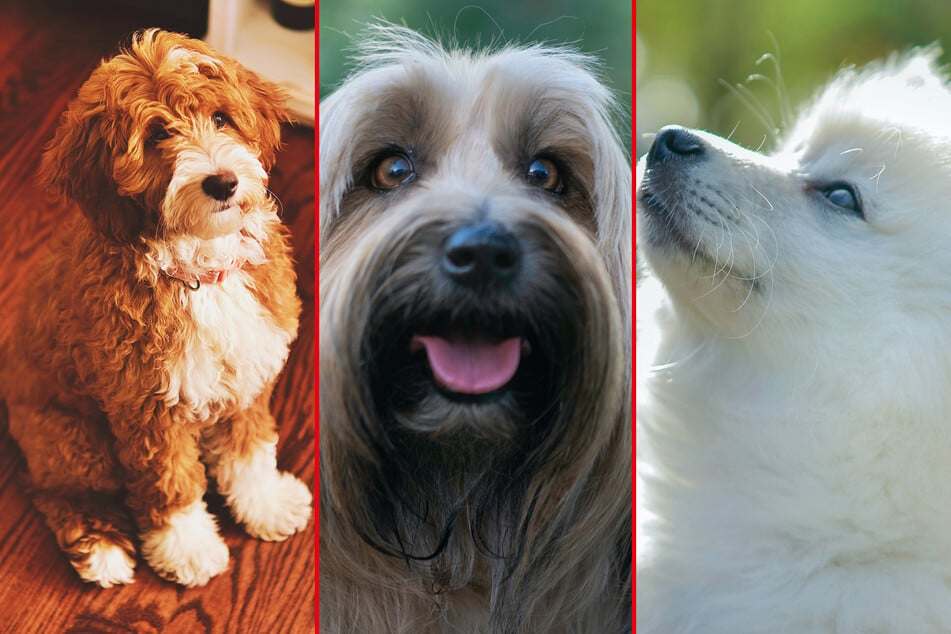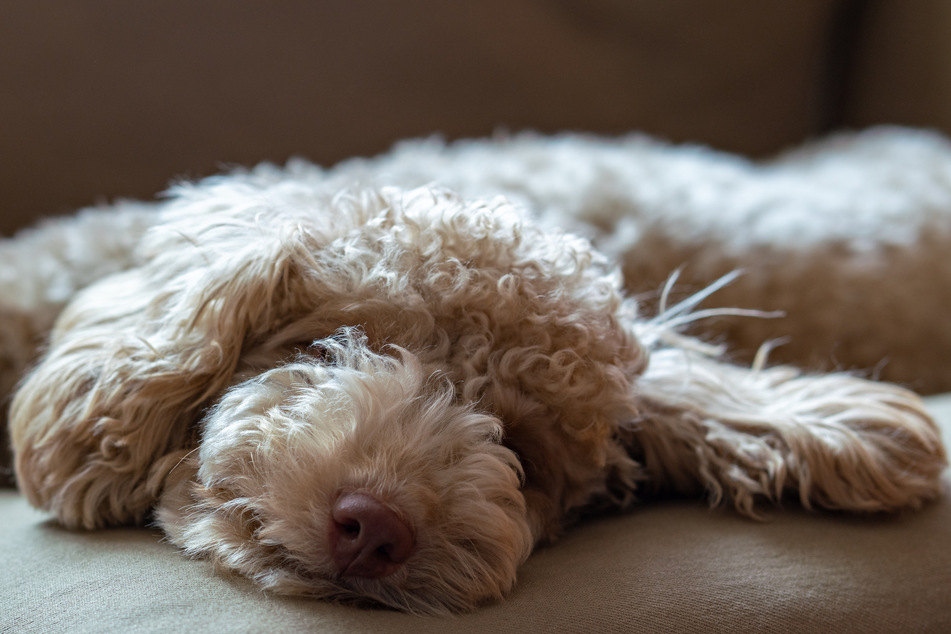All types of dog coat: Different dog hair colors and patterns
There are many different types of dog fur, each lending itself its own advantages and disadvantages. Let's take a look at all the dog coat types out there, the most common colors, and everything else you need to know.

Dogs can be curly, dogs can be fluffy, dogs can be black, dogs can be white...there are many things a dog can be, but the first thing you'll always notice is its coat. There are many types of dog coats out in the world, with their hair coming in many shades and styles.
In this dog guide, TAG24 will take a look at every type of dog coat in the world. What colors do they come in, what do they look like, what patterns are there, and what else do you need to know about dog hair?
What are the different types of dog coats?
Dog hair has many different characteristics, with individual dogs often featuring more than just one coat type on different areas of their body. The double coat is a classic example of that but is not exclusive. Your canine companion's hairy jacket is one of its defining characteristics, lending it a particular look that'll never be forgotten even well after it's gone.
As a result, it seems about time to take a look at all the world's various dog coat types. Which coats are the cutest, which are the ugliest, and what do you need to know about your dog's fur?

Double vs. single-coated dog hair
Every dog is either a single or double-coated dog, meaning that it either has one layer over its entire body or is covered by an inner layer of fur and an outer layer of hair. It's also worth mentioning that the length of a dog's hair or fur is not necessarily indicative of whether it's a double-coated dog or not - though longer-haired dogs will often be double-coated.
Double-coated dogs characteristically have a second layer of hair, generally fur, that is found beneath the visible coat we've all come to love. This hair is typically thicker and woollier and is used to keep it warm in cold environments. Dogs with double coats can be particularly bad for those who suffer from allergies, as they often shed their entire undercoat as the seasons change.
Most dogs, though, are single-coated. This means that they have no undercoat and feature just one layer of fur or hair on their bodies. These coats can take on almost any other characteristics - they can be curly, silky, wavy, or smooth and short.
Almost all the dog coats we talk about from here on out can either fit into one or both of these categories. It's worth checking what your dog has before you adopt it, as well, because double-coated dogs will often require more grooming.
Curly dog hair

Curly-haired dogs are, more or less, exactly as they sound. Often very soft, though a bit tangled, these little fellas are covered in beautiful curls. There are some incredible curly dog breeds out there in the world, and they are exceedingly popular coats among small and medium-sized doggos.
Here are a few of the most popular curly dog breeds:
- Poodles
- Bichon Frise
- Pumi
- Bedlington terrier
- Barbet
- Puli
- Komondor
If you're looking for an extra fluffy fella, curly dog breeds are certainly a good place to start.
Silky and soft-coated dogs

Silky and soft-coated dogs are all about the texture and feel of their fur and hair rather than the specific structure or look that it provides. As the name of this coat type suggests, these dog coats will be smooth and soft to the touch. Silky and soft-coated doggos are often insanely elegant - these are some of the prettiest dogs in the world!
Here are a few of the silkiest and softest dog breeds in the world:
- Samoyed
- Siberian husky
- Alaskan Malamute
- Golden retriever
- Australian Shepherd
Don't mistake silkiness and softness for fuzziness; they're different things. Also, keep in mind that silky dogs are particularly prone to shedding.
Short and long dog hair lengths
Most dogs will either have naturally long hair or naturally short hair. Of course, there are medium-haired dogs as well that fit into the middle, but most of our favorite canines will fit into this dichotomy.
Long-haired dogs will often shed less, though, because their hair is used to growing much longer before being let go. They'll also be harder to keep looking brushed and well-kept. On the flip side, shorter fur or hair will often be easier to brush and look after but is often significantly less elegant.
The glossiness and look of your dog will often be determined by the length of its fur. This is why it's important to get them trimmed and groomed every now and again.
Hairless dogs

Hairless dogs are not nearly as common or well-known as their feline equivalents, and it's probably for a good reason. Types like the Chinese crested dog and the bull terrier often make it onto lists of the world's ugliest dog breeds, even if it may seem unfair (after all, the ugliest dog in the world is a shih-tzu and chihuahua cross).
Here are some examples of hairless dog breeds:
- Chinese crested
- Mexican hairless dog
- Peruvian Inca Orchid
- Chihuahua
- American hairless terrier
Keep in mind, though, that while defined as "hairless," all of these breeds do have a very short and thick layer of fur on their skin - it's just so little that they look hairless.
Dogs with smooth coats or spots

Smooth-coated dogs are often mistaken for being hairless, and in some cases, there is a crossover. The most famous example of a smooth coat is one that also comes with spots: The Dalmatian! Famous for featuring in a classic 1961 Disney film, dalmatians are some of the more elegant of their coat type.
Here are some smooth-coated or spotted dog breeds:
- Labrador retriever
- Afghan hound
- Great Dane
- Chihuahua
- Boxer
- Beagle
Unlike hairless dogs, which are characterized as being some pretty ugly creatures, smooth-coated or spotted dogs can be insanely cute.
Rough and wire-coated dogs

Most double-coated dogs will feature a rougher interior coat designed to be dense and warm. Others, though, will have that rougher layer on the outside. While not every wire-coated dog will be double-coated as well, it is quite common and something to look out for.
Here are some wire-coated dog breeds to keep an eye out for:
- Wire fox terrier
- Jack Russell terrier
- Wirehaired vizsla
- Scottish terrier
- Irish wolfhound
Wire-haired or wire-coated doggos can generally be recognized as dogs that have exceptionally spiky, messy, and textured outer fur.
How to tell if a dog has a double coat
While most dog coat types are easy to distinguish (if your dog has curly hair, it's pretty obvious), determining whether the dog you're adopting is single or double-coated can be a little more difficult. Often the lower layer is obscured by the top layer of hair, making it impossible to recognize without checking properly.
You should find out before adopting, though, because you need to know what you're getting into when you get a dog. Are you going to suffer from more allergies, is the grooming process going to be too hard for you, do you live somewhere that'll be too cold for a single-coated pup or too hot for a double-coated one? These are all important questions.
If you are unsure what kind of coat your dog has, there's a very simple test to find out whether it is single or double-coated: Simply stroke your canine companion against the grain of its hair! If you see its skin underneath, it's a single coated doggo, if you see shorter and denser fur, it's a double coated pup.
Dogs with the softest fur
Whatever the specific dog coat you're looking for, one of the most important things to consider is how soft and cuddly it is. With that in mind, it seems fitting to finish up this collection of lists with one dedicated to the softest canine companions around!
Here are some of the softest dog breeds in the world:
- Samoyed
- Bichon Frise
- Pomeranian
- Maltese
- Chow Chow
- Bolognese
- Basically, any dog that could be described as "puffy"
Always give the dog you want to adopt a cuddle before signing the paperwork - you want to make sure that the two of you have chemistry before committing to the relationship.
Do dogs have hair or fur?
Whether your dog has hair or fur is entirely based on the density of its coat - if it has a thicker and coarser texture, it can be considered fur, if it is thinner and softer, it's likely to be hair. On top of that, hair will generally come in more styles and types - fur will never be wavy, curly, or super long, but it might be shorter and denser.
On top of that, fur has a shorter growth cycle and will more commonly shed. This is why cats often trigger allergies more than dogs do because every cat has fur, not hair, and they shed like crazy. Some doggos even have both hair and fur, with double coats often featuring a thicker fur layer on the interior, covered in an outside coat of hair.
Whatever coat your dog wears, whatever color its fur or hair adopts, whether your dog has hair or fur, none of this really matters. What's most important is that your doggo is huggable, and, let's be real, that's a given, no matter the breed or coat type.
Cover photo: Collage: Unsplash/Leiada Krozjhen/Cristina Anne Costello




